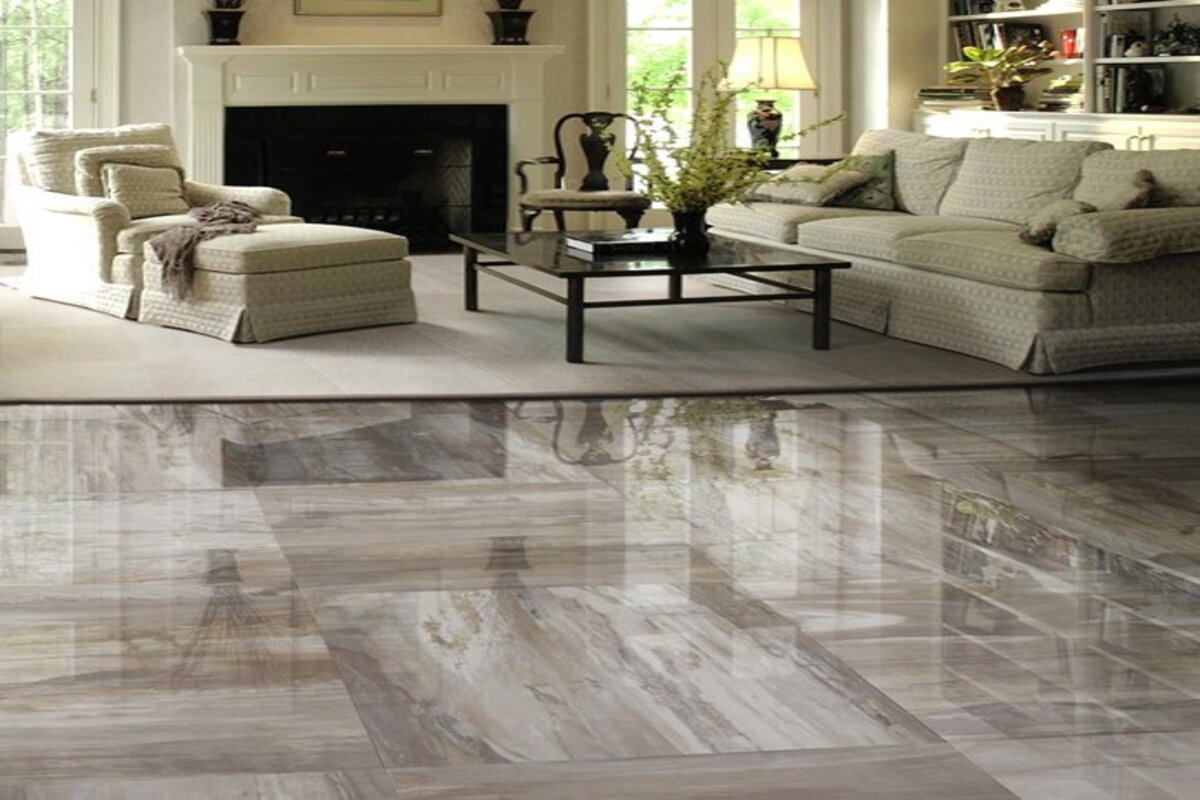There’s something about basements that feels a little mysterious, like they’re the introverts of the house. Quiet, a little dark, and full of secrets. But when it comes to giving your basement a makeover, the biggest mystery is often the floor. Between surprise leaks, fluctuating humidity, and the eternal struggle against mold, picking the right basement flooring options is much more strategic than it seems. If you want your basement to be a cozy hangout zone, you’ll want flooring that knows how to keep its cool under pressure. Literally. Continue reading below for expert insights from the team at Karin Ross Designs.
Basement Flooring Ideas
If your Pinterest board is full of dreamy basements with faux wood floors and cozy rugs, you’re not alone. The key to pulling off this look is choosing basement flooring options that can handle moisture without warping, cracking, or attracting mold.
Some of the best flooring for basements include vinyl planks, ceramic tile, stained concrete, and rubber flooring. These materials are known for being moisture-resistant, low maintenance, and durable. Plus, many of them come in designs that mimic hardwood or stone, so you’re not sacrificing style just to keep things dry.
Another underrated idea is interlocking foam or rubber tiles. They’re easy to install and great for playrooms or gyms. Plus, if a leak happens, you can easily pop up and replace only the affected tiles instead of needing to reinstall your entire floor.
What Type of Flooring Is Best for Basements?
The best flooring for basement spaces depends on how you plan to use the area and how moisture-prone your basement tends to be.
For spaces with higher humidity or a history of minor flooding, ceramic or porcelain tile is a top-tier option. These are basically waterproof and very easy to clean. For something softer underfoot, luxury vinyl planks (LVP) are another option. They’re stylish, moisture-resistant, and don’t require glue or nails. Not using glue is important because moisture can cause the adhesive to fail over time.
Skip anything that involves organic material, such as hardwood or traditional carpet padding. Moisture can easily sneak into those fibers and begin creating mold.
How to Prevent Moisture on the Basement Floor
Moisture prevention isn’t just about the floor. It’s about creating an environment where water doesn’t feel welcome.
First, fix any drainage issues outside your home. Make sure your gutters are clean and that water flows away from the foundation. Inside, a combo of a sump pump, vapor barriers, and a good dehumidifier will do wonders.
You can also install moisture sensors or alarms to catch leaks before they turn into a full-blown flood. If your basement is partially finished, make sure your drywall and insulation are also moisture-resistant. Moisture doesn’t always show up where you expect it.
How to Seal a Basement Floor for Moisture
Before laying down your chic new LVP or dreamy tile, you must make sure the concrete slab underneath isn’t sweating. Learning how to seal basement floor surfaces properly is the first step to a successful, long-lasting floor install.
Start with a clean, dry surface. Use a dehumidifier in the days before sealing to ensure you haven’t trapped in any dampness. Next, apply a concrete sealer. The sealer can either be a penetrating sealer that soaks into the concrete or a surface sealer that forms a protective barrier on top. It’s integral that you don’t skip this step. A basement flooring moisture barrier is your insurance policy against future leaks or condensation build-up ruining your entire vibe.
After sealing, let the floor cure completely before installing your new floors. Though waiting can be difficult, your future self and mold-free flooring will be grateful.
Does Insulation Between Floor Joists Help Reduce Moisture in Basement?
Does insulation reduce moisture? Yes and no, as this question is a little more complicated. Insulating between floor joists can help regulate the temperature of the floor above and reduce condensation caused by temperature differences. However, it’s not a silver bullet for moisture issues.
To make it work, use insulation materials that are designed for below-grade applications, like closed-cell spray foam or rigid foam boards. These don’t absorb water and can act as both insulation and vapor barriers. Always pair insulation with proper ventilation to avoid trapping moisture where it shouldn’t be.
In short, insulation helps, but only when combined with a bigger moisture-control strategy.
What Is Normal Moisture Content of a Basement Floor?
If you’re interested in the science behind proper basement flooring and moisture levels, the normal moisture content for a concrete basement floor should be below 4% when measured with a moisture meter. Anything above that is flirting with disaster, including mold and mildew.
It’s especially important to check your moisture levels before installing new flooring. Many moisture-resistant flooring for basements will have manufacturer-recommended moisture levels for the subfloor. Ignoring those guidelines could void your warranty and leave you with a mess.
To ensure the most accurate results for moisture levels, always test in multiple spots across the basement, especially near exterior walls and around any previous water entry points.
Can Carpet Work in a Basement?
Though carpet can work in a basement, you must proceed with caution. Carpets in basements might be cozy, but they’re also sponges for moisture. This moisture can lead to mold, smells, and allergy triggers.
For anyone set on carpet, it’s best to use carpet tiles with moisture-resistant backing. They’re easier to replace if part of the floor gets wet. Pair these with a proper vapor barrier and a dehumidifier, and you should end up with the carpet flooring of your dreams.
If you are considering carpet because warmth is your goal, consider a cork or engineered vinyl floor with an area rug on top. It’s a safer way to get a cozy aesthetic without the higher risk of mold forming.
Can You Use Hardwood Flooring in a Basement?
Unfortunately, real hardwood is not on the list of recommended flooring for basement use. This material is much too sensitive to moisture, and even small humidity changes can cause it to warp or cup.
However, engineered hardwood is a solid alternative. It’s made with layers that help resist moisture better than traditional hardwood. Though it’s not totally waterproof, it’s best for low-moisture basements with a good vapor barrier and dehumidifier in place.
If you must achieve the wooden look, luxury vinyl planks or waterproof laminate with wood-looking finishes are safer alternatives. They’re much more durable while still giving you that polished finish.
Should I Use a Subfloor System?
If your basement feels more like a cave than a cozy retreat, a subfloor system could be a game-changer. Systems like DRIcore or insulated panels can raise your flooring off the concrete, create a moisture barrier, and add insulation for warmth.
These systems are particularly useful if you’re using floating floors such as vinyl or laminate. Subfloor systems also make it easier to run wiring or in-floor heating systems underneath. This is great if you’re designing a full-blown basement apartment or luxe hangout space.
Keep in mind that subfloor systems cost more upfront, but they’re worth it if you’re investing in long-term comfort and durability.
Final Thoughts and Your Next Move
Basements can be tricky, but with the right planning, they can also be some of the coolest, both literally and aesthetically, spots in your home. Choosing the right basement flooring options comes down to balancing style, durability, and moisture resistance.
Whether you go with tile, vinyl, rubber, or even engineered wood, make sure to seal your concrete, install a proper basement flooring moisture barrier, and tackle moisture issues before they become disasters. Remember that it doesn’t matter how pretty your basement looked at first if your floor ends up floating in a puddle.
Need help turning your under-home space into a luxurious lair? Our bathroom remodeling company in Kansas City handles all types of remodeling, including basement transformations. Head over to our kitchen and bath remodeling blog for more inspiration. You can also schedule a remodeling consultation today. Your basement deserves more, and so do you.










